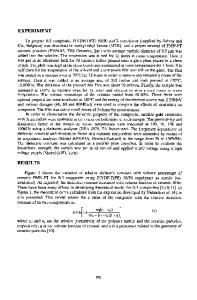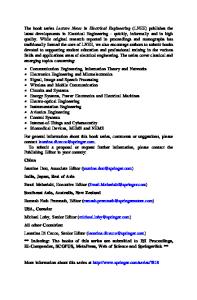High Power Switching Behavior in Conductor-Filled Polymer Composites
- PDF / 379,769 Bytes
- 6 Pages / 414.72 x 648 pts Page_size
- 67 Downloads / 314 Views
ABSTRACT It has generally been assumed that the switching properties of conductor-filled polymer composites are based on a positive temperature coefficient of resistance (PTCR) effect where, at a certain switch temperature, the material resistivity increases by orders of magnitude. Here we present studies of the electrical switching behavior at high current densities which demonstrate that, in the high power regime, the observed switching is not based on the PTCR effect. Instead, we show that this type of switching appears to be a general feature in conductor-filled polymer composite materials and a qualitative model for the switching phenomenon is proposed. These results suggest that conductor-filled polymer composite materials can provide a new nonmechanical way of rapidly limiting high power short circuit currents. This should have broad applications in the circuit protection industry. INTRODUCTION It has been known for over 30 years that certain conductor-filled polymer composites exhibit reversible switching from a low to a high resistance when electrical currents above a certain magnitude are run through them [1-4]. These materials exhibit a positive termperature coefficient of resistance (PTCR) effect where, at a certain temperature, the material resistivity increases by orders of magnitude. The most studied polymer-composite system which exhibits this effect consists of polyethylene (PE) loaded with carbon black (CB). The temperature dependence of the resistivity of a particular PE/CB PTCR material is shown in Figure 1. At temperatures below the -130C melting point of PE, the resistivity does not depend strongly on 'temperature; at 130C, the resistivity rises by orders of magnitude. This anomalous resistivity increase is believed to be due to an increase in GB particle separation resulting from the discontinuous PE expansion upon melting [5-6]. The PTCR property of these materials explains their reversible switching as a function of current and forms the basis for their use as current limiting devices in electrical circuits. In overload conditions, the joule-heating due to the excess current causes the material temperature to rise above the PTCR transition temperature thereby causing the material to switch to its high resistance state. In this state, the overload current is limited to an acceptable value. When the overload condition is cleared, the device cools to below its switch temperature and normal circuit operation is resumed [7]. Until recently, current limiting devices based on the PTCR effect have all been designed for low power circuit applications. Recently, a current-limiting device utilizing a PE/CB PTCR material was designed for much higher power circuit applications where the system voltage is on the order of 450V and the maximum current during a short-circuit is on the order of 100 kA [8]. As a result of material damage, this device is only designed for -5 current limiting operations but this still provides a substantial performance advantage when compared to conventional methods of high pow
Data Loading...











